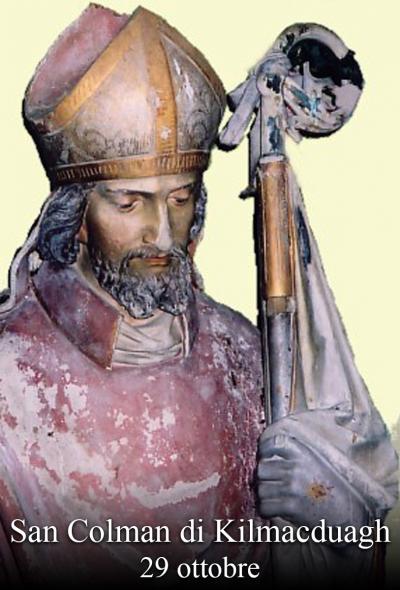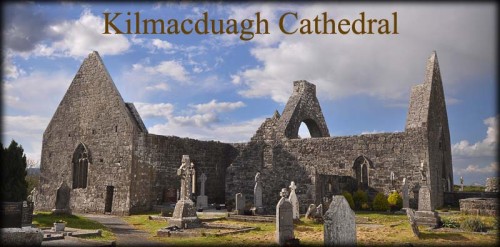
Image source from https://www.santodelgiorno.it/san-colman-di-kilmacduagh/
The material below has been distilled from
The Martyrology of Donegal, refers to Bishop Colman Mac Duagh of the diocese of Cill Mic Duach in Connaught. Colman was of the Fiachra race, and the son of Eochaid Muidhmheadoin. Our Fiachra saint was a man of immense virtues and miracles.
His story is like a drama which unfolds, beholds, and must be told.
In the 6th century, a woman called Rhinagh was at an advanced stage of pregnancy. A king of Connaught developed a jealous hatred of Rhinagh after hearing a prophecy of authority, about her soon to be born son, the St. Colman to be. According to a prophecy, Rhinagh’s son was destined to surpass in greatness, all within the Fiachra clan dynasty. This king also called Colman, was father of prince Guaire, and relative of the child to be born. The King wished the child to be done away with… Now fearing the hostile jealous king, Rhinagh fled in a panic in an attempt save her unborn child. The jealous king pursued her, and his minions took her, and put a heavy stone tied around her neck. They then cast her into the deep depths of the river Kiltartan… However, the mother to be, was preserved from drowning, by some miracle.
Rhinagh gave birth to her son in secret at a place called Corker near Gort, in County Galway. Her boy was born with a thousand blessings which time has brought to ripeness. The concerned mother placed her baby under a shelter of an ash tree, and waited irritably for someone who might baptise her new born child. It happened that two aged pilgrim religious men past by, seeing the anxious mother. One was blind, the other was lame. They both could not procure any water to administer baptism, so they called out for Divine assistance. Suddenly a fountain spring gushed forth from beneath the shelter of the ash tree. The two religious were able to baptise the child and name him Colman at Corker, at the Holy Well which now bears his name. Then having washed themselves in the well spring waters of the two religious men were cured of blindness and infirmity. These indebted monks, recognising the greatness of the child, intreated the mother to commend Colman to their care, for his protection and education. Under the distressing circumstances of being a fugitive, Rhinagh was only too happy to entrust her son into their care. She recognised that Colman would be kept from harm from a hostile and jealous king. The child lived a life largely unknown for many years from this point. We can see that it somewhat reflects that of the child Jesus who fled to Egypt, and later lived in Nazareth a private life until his public ministry began.
Colman reappears later in the maturity of life on ”Inis Mór”, also known as the island of the Saints – “Ara-na-Naomh.” St. Enda was the abbot there and his foundation had a reputation for piety that rivalled St. Colmcille’s foundation at Iona. Two churches on the island are ascribed to St. Colman, both by “history and tradition according to Dr. Kelly. The austere and solitude life on Aranmore, practiced by the holy disciples of St Enda, was not sufficient for the generous soul of Colman. So by the end of the sixth century, he left the island, to spearhead a new religious foundation of greater solitude and austerity.
We must appreciate that Ireland was very much a forested country in this era, and St. Colman Mac Duagh pursued isolation to be found in the Burren forests. The global weather was much more Mediterranean like in what can only be described as another world. At the Burren forests, Colman found the perfect seclusion to be alone with God. Here he lived the desert life like that of John the Baptist. He was resolved to practice penance and contemplation in complete solitude and retirement of his hermitage.
A historian Colgan narrates that St Colman retired to Burren forests, accompanied by a religious attendant, while king Colman was still at large. It was therefore a grave matter to conceal the place of his hermitage. Colman constructed a small oratory at the foot of the cliff of Ceanaille. Tradition tells of a cave used for his hermitage with a fountain of water that provided him with drink. Colman ate wild herbs of the forest, and he wore skins of the wild deer as raiment. His fasts, prayers and vigils, were frequent.
In the solitude, Colman was often absorbed in ecstasy of the most abundant spiritual consolations. He also suffered moments of aridity though, when God seemed to have forsaken him. The historian Keating narrated that Colman settled into the desert wilderness for the sake of increased devotion. His only creature comforts were the religious company of his attendant, a rooster, a mouse, and a fly. The Rooster gave him notice of the time of night prayer by his crowing. The mouse, kept him from sleeping above five hours a day; for any relaxing or dosing off on his ascetic life, that mouse would come along and scratch Colman’s ear until he was perfectly re-awakened. The fly was like his reading attendant, having the sense to crawl along the lines of his spiritual readings; and if the Saint had tired eyes, the fly would stop awhile, marking the first letter of the following sentence, directing Colman back to where he finished reading.
Colman lived in his Burren hermitage for seven years in complete isolation and unknown… The time came however when he would leave the solitude, as he was made a bishop of his people. Prince Guaire succeeded the throne of Connaught, as King Colman and Guaire’s older brother passed away. Guaire of the Hy Fiachra clan proved to be a good Godly King, and a great friend to Colman; for they were kinsmen. There family friendship proved to be a powerful combination.
King Guaire, with patient effort and divine help, discovered the Burren hermitage. The sanctity of the place, made a big impression on him. It was King Guaire would soon urge Colman to accept the episcopal charge of the territory of Aidhne. Colgan, narrates this episode, taking details from the Menology of Aengus, thus paraphrased:
It happened that St. Colman, on Easter morning, recited his prayers and celebrated the Holy Mass. Expecting a feast, he asked his attendant if there was anything special to eat for the great feast of the Risen Lord. The attendant had only been able to procure some small wild fowl and some herbs. Colman saw his attend pining for something worthy of a feast. So the saint left this famished attendant in the hands of God. Colman prayed that if it be the divine will, God would send heaven’s servants to supply a feast and strengthen his attendant’s faith.
King Guaire meanwhile was hosting a royal banquet at his palace some great distance away at Durlus. When all the notable people present were ready to partake, something mysterious happened. Before sitting down to the feast, King Guaire gave an impressive speech. “Oh, would it pleased Heaven that this banquet were set before some true servants of God who require it; as for us, we might easily be provided with another.” Well no sooner had he uttered such words, the dishes were raised from the tables and removed, as if by invisible hands. The banquet guests and attendants were dumb struck. The king marvelled, ordering his guards, to follow the dishes, to determine if possible their new destination. All the King’s men followed the dishes in hot pursuit. They were then followed by a crowd of passing witnesses. The dishes finally arrived at Colman’s Burren hermitage, and were arranged in the open space in the woodland. Colman and his attendant exclaimed, ” O father, behold the reward of thy patience! Let us thankfully partake of the food sent us by our good God.” Colman, first investigated where such dishes had come from, and an angel recounted that the feast was sent in answer to his prayers, and through the generosity of the king. Suddenly His Majesty, King Guaire with his subjects and the gathered crowd of witnesses arrived on the scene.
All were in astonishment at discovering the secluded hermitage and the banquet laid before Colman and his attendant, who were on the point of feasting on the bountiful providence of the Lord. Before the crowds could join them, Colman desired that his starving attendant could enjoy the delights set before him there and then without any further waiting. The king’s men and the crowd were momentarily unable to advance to their place at the banquet. The limestone ledges bear, to this day, the footprints of the crowds whose feet sank and anchored into the stone ground. Colgan, narrates this phenomenon in folklore which happened at a place called ” Bohir na Maes,” which is Irish for the road of the Dishes.
The holy character of the Burren hermitage won for Colman, much public acclaim among his clansmen. His fame for austerity and miracles became well known among the Fiachra race. What is more Colman was one of their own, from the noblest of the tribes of Hy Fiachrach. King Guaire, urgently requested St. Colman to found a monastery, and be accept an episcopal charge of the territory of his kinsman. With the monastery built, the abbot was elected by an apostolic mandate to the dignity of bishop. Colman exercised episcopal jurisdiction, coextensive with the territory of his race. It extended over the territory of Aidhne, the patrimony of the southern Hy Fiachrach, becoming the boundaries of the diocese of Kilmacduagh. The site of Colman’s monastery and cathedral was miraculously pointed out to him.

Image source Oct 29 – St Colman of Kilmacduagh (560-632) – Catholicireland.netCatholicireland.net
Colgan narrates; “his cincture fell on a certain place, not far from his former cell, and there he built his monastery, which, from his name, is commonly called Kilmacduagh.” The location had the qualities of solitude and was dangerous for the public to reach. It became a refuge to many desperately fleeing from one problem or other. The date of the foundations of this monastery at Kilmacduagh is given as A.D. 610.
Bishop Colman would often reminisce over the solitude he once enjoyed, and wished to have it all back to be able to enjoy the divine communion which he often had with God. He found himself as bishop, despising the praises and admiration of all. Bishop Colman lived out the remainder of his days in the secluded little valley of Oughtmama in the Burren. The rugged mountains rise steeply round this valley, completely hiding it from the public access.
Colman gave up his soul to his Maker on the 29th of October A.D. 632, in the pontificate of Honorius I. The festival of St. Colman Mac Duagh has been observed in the diocese of Kilmacduagh from time immemorial on the 29th of October.